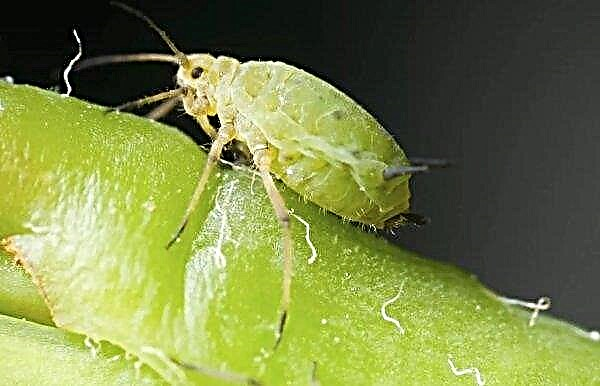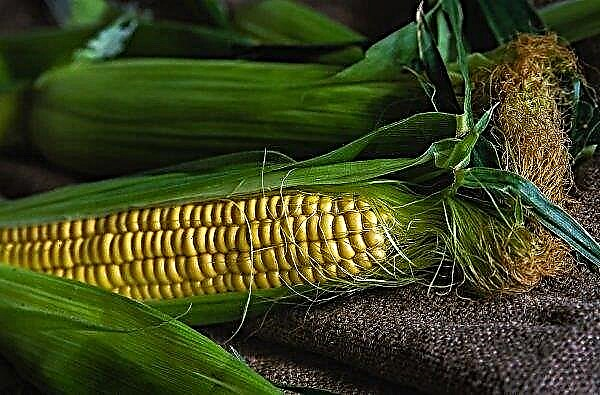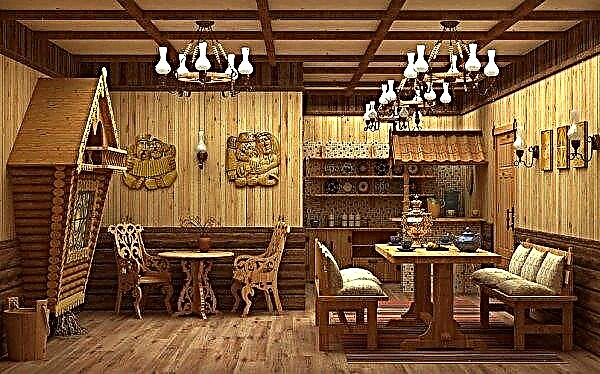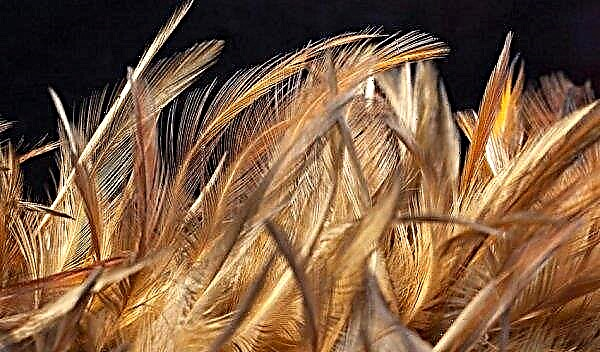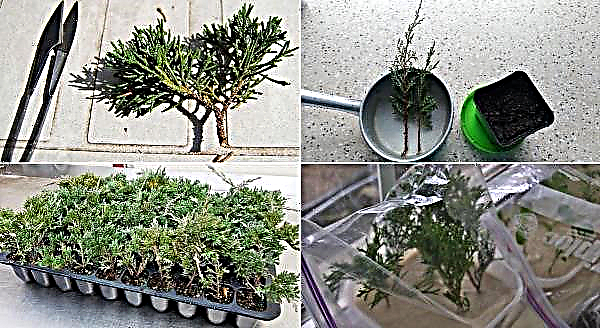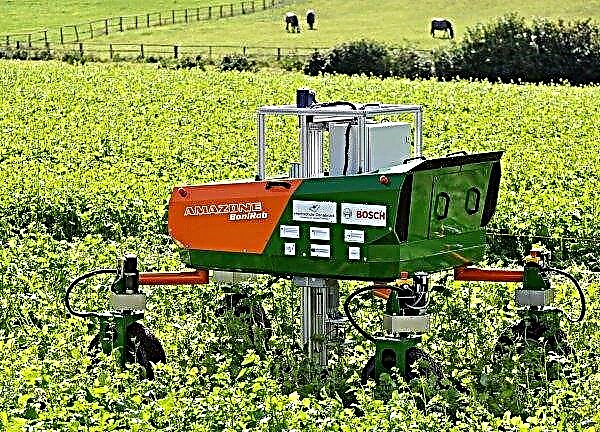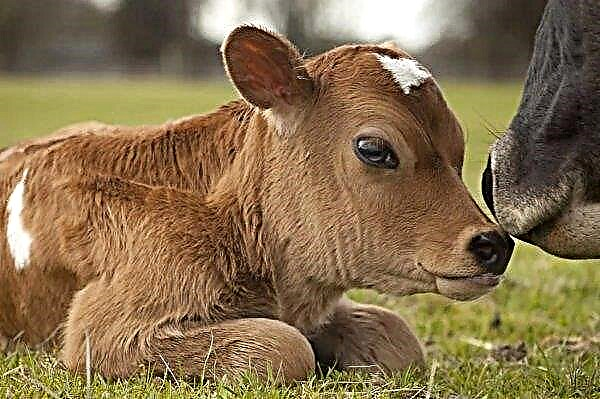The article will focus on the brooder, or design, which is designed to replace mother hens with chickens, heating them in the first days of life. This device will be especially useful when buying a large batch of chicks, when there is no way to pay attention to each of them. How to assemble a brooder with your own hands, making it effective and safe for babies - read on.
What is a broiler for chickens
As a brooder, you can use cardboard boxes, boxes, cages, cabinets or even part of the room. This space is organized according to the requirements described below to provide comfort to chickens.
Did you know? Ndesign name «brooder "was formed from the English. "Brood" - «hatch eggs».
The main advantage of such a “brood” is the opportunity to provide the chicks with conditions for full development.
In addition, a brooder is necessary to control several factors:
- ensuring the desired temperature;
- humidity control;
- ability to feed the feed so that the chicks do not overeat.
 But the brooder also has one significant drawback: there is always the possibility of overheating of chickens, so it is necessary to constantly monitor the temperature in space.
But the brooder also has one significant drawback: there is always the possibility of overheating of chickens, so it is necessary to constantly monitor the temperature in space.Main functions
Broader tasks include:
- providing youngsters with a comfortable thermal regime, heating;
- protection of chickens from drafts, dampness;
- fresh air supply to the construction.
Bruder Requirements
To such a device, they can be divided into objective and subjective.
The first group includes the following conditions:
- the floor in the brooder should be non-slip and dry so that the chickens are not injured and do not get sick; under it it is desirable to arrange a litter pan;
- it is necessary to ensure high-quality ventilation in the structure, otherwise there is a risk of formation of increased humidity;
- space overheating should not be allowed;
- chicks should not have direct access to a heat source.
Important! It’s important to keep in mind tightness so that chickens do not crush each other.
Subjective requirements include price and durability: how much are you willing to spend on arranging a brooder, and how long do you plan to use it. If it is needed only for one season, a capacious cardboard box is quite suitable, and for regular use you will have to spend money on a finished device or its own creation.
Design features
A brooder usually consists of the following elements:
- floors, walls, covers;
- a heater that maintains the temperature in space;
- a lamp that provides lighting;
- feeding troughs;
- drinkers;
- ventilation ducts;
- removable pallet under the floor.
Did you know? The level of chicken intelligence allows them to memorize the distinguishing features of about a hundred other birds and even people, so that they distinguish those who acted badly or well towards them.
How to make a DIY broiler for chicken
As you can see from the above list, no complicated and expensive materials will be needed to make a home-made brooder. And how to make it on your own? Information below.
Size calculation
Dimensional characteristics depend on several criteria:
- the material from which the structure will be made;
- the number of chickens that will live there;
- How old are the chicks to be placed?
Important! Up to 50 day old chickens can be kept on an area of 1 x 0.5 m so that the landing density is not disturbed. The average height of this design is 50 cm.
Tools and materials for work
To create a brooder (for 50 chickens) 1m x 0.5 m in size and 35 cm high, you will need:
- 4 3-meter timber 30 x 40;
- Fiberboard;
- wood screws;
- press washers (13 and 20 mm);
- board 1000 x 250 mm;
- mesh for the floor;
- a small piece of polycarbonate and end strips;
- drywall profile (60 mm x 28 mm);
- wire for electricity;
- lamp for lighting.
Of the tools useful:
- drill;
- screwdriver;
- wood hacksaw;
- roulette;
- pencil for notes.
If you plan to make a broiler for 100 chickens, then double the size of this. But it would be better to make two separate structures smaller.
How to make a broiler for chickens: video
Step-by-step construction instructions
Having prepared the necessary materials and tools, proceed to the assembly of the brooder:
- First: a bar. You will need 4 pcs. 1 m each (horizontal levels), 4 pcs. 0.45 m each (vertical legs), 2 pcs. 0.42 m each, 1 pc. 0.32 m each (vertical stand), 1 pc. 0.48 m (under the bunker feeder), 2 pcs. 0.47 m and 2 pcs. 0.23 m (vertical and horizontal racks for the doorway). For convenience, you can immediately sign each segment according to its purpose, size, as well as orientation (top-bottom). Leave the remaining timber to create a pallet.
- Then prepare a board 100 x 25 cm, sawing it into two sections of 420 mm.
- Directly start the assembly with vertical legs (4 pcs. At 0.45 m). Measure 35 ml with a tape measure (this will be the floor level). Drill holes on both sides at a distance of 15 ml from the edge of the segment. This measure will facilitate further assembly and protect the timber from cracking.
- Drill additional holes in the upper part (at a distance of 15-20 and 40-45 mm from the edge), but already on the other side of the beam and make sure that they do not intersect with the first.
- Repeat all these steps with the remaining three legs.
- Having the finished parts, screw the screws in the top of the timber (on the side opposite the first hole) with a screwdriver.
- Now tightly press the meter ruler (horizontal level) at a right angle and fasten them with a screw.
- Repeat on the other side with the foot level. This will be the top of the structure.
- Make the bottom by connecting the two legs together with a meter beam to make a rectangle. If you remember, the floor level was measured with a tape measure - that's according to this label and fasten the lower horizontal level.
- From the remaining two meter sections and two legs of 0.45 m, make another same frame. The result is two blank frame.
- Next, take one of the two pieces of the board and screw it to the top of the frame (where two holes on the leg were made).
- With the second section of the board, repeat the action on the other side.
- Under the board, at the level of the floor mark, fasten one of the boards of 0.42 m: it will be needed to fix the fiberboard wall. Do the same on the other side.
- Attach the second frame to the boards and lower bars. You should get a rectangular frame on the legs.
- From the fiberboard, make the back cover 1 m by 0.5 m, but do not fix it yet.
- On the front of the future brooder, lay a block prepared under the bunker feeder on the lower level of the frame and attach it with screws.
- Next to the lower frame, put the separation column from the timber, and on the other hand, assemble the door from pieces of 0.47 and 0.23 m and tighten with screws. The gap above can be closed with polycarbonate.
- Screw the hinges inside out to the door frame using smaller tapping screws. Then attach the hinges to the frame. If gaps form, use pieces of fiberboard.
- Now get down to preparing the floor. Attach small slats to the lower horizontal levels to stabilize the mesh.
- Then cut out the side walls according to the actual size. It will take 2 pieces of approximately 0.47 x 0.315 m and 0.47 x 1 m in size. Do not fasten the walls yet.
- In the side wall, you can make additional ventilation. The prepared fiberboard canvas will help in this (its dimensions were measured above: 0.47 x 0.315 m), in which a small rectangle (15 x 7 cm) is highlighted below, within which holes are made using a drill.
- Above this segment, fix a proportional piece of the bar to which you need to fasten the end plate from polycarbonate, which will be used as a guide. We attach the second such segment to the board from the inside. As a result, on both sides of the holes, slats should be obtained along which the valve for ventilation will move. You can make it from a small canvas fiberboard.
- Measure the grid for the floor. Approximately it should turn out 0.46 x 1 m. If you have a fine-mesh, designed for chickens, then you can put it in one layer. If you plan to use a larger one, then you will have to put a grid for the house on it from the inside.
- We fasten the mesh with press washers so that the screws overlap each other, to two thin strips or bars that remained after cutting, from the narrow side. You should get a floor that fits comfortably on the lower frame of the frame.
- Now place the side panels and the back cover.
- Next, cut polycarbonate onto the door according to the size of the opening and attach it. Carefully attach the latch.
- From the side of the feeder, you can add a wall from the grid so that the chicks do not get out of the brooder. Cover the net with polycarbonate.


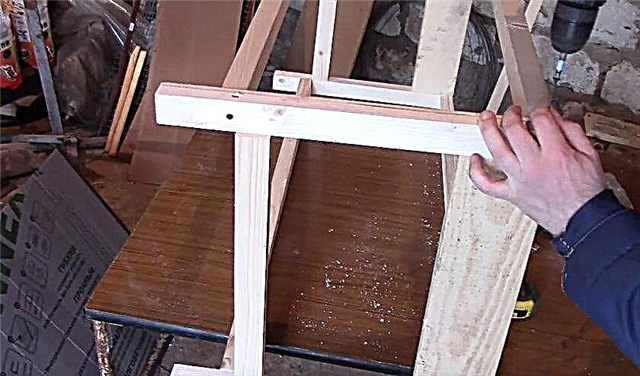



Given that the outer walls are made of fiberboard, then it does not hurt to think about how to process them for safety. Any antifungal agents approved for use next to animals will do.
Did you know? Due to their anatomy and body design, chickens are recognized as descendants of tyrannosaurs - large predators from the era of dinosaurs.
Installation of feeders and drinking bowls
A special beam was attached to the hopper feeder during the main assembly of the brooder.
It's time to finish the job:
- Take a drywall profile. Using wire cutters, wrap one edge inward so that the feed does not spill out.
- Measure the desired length, cut to this measure and also wrap on the other side.
- Next, you need to fasten a piece of fiberboard and washers to one of the long sides of the profile — back and side walls.
- Insert the feeder into the frame and attach it.
- Now we build a wall of fiberboard, which will limit the feed. To do this, take a measurement and cut it with a hacksaw, making gaps so that you can adjust the feed.
Important! If possible, it is best to use nipple drinkers with a dosed water supply in the brooder. Then the chickens will not wet their paws, and the floor will always be dry.
Lighting and temperature in the brooder
Important questions regarding heating and lighting of the brooder remained unsolved, namely:
- To conduct electricity, you need a 0.75 ml wire. If desired, you can add a socket with a switch.
- Using a plaque, secure the lamp holder from the inside of the top brooder by passing the wire through the hole.
- Insert the lamp into the socket, connect the electricity.
 In addition to lamps for lighting, a brooder may still need a device for heating, since it is very important to observe a certain temperature regime for chickens.
In addition to lamps for lighting, a brooder may still need a device for heating, since it is very important to observe a certain temperature regime for chickens.| Day | Temperature ° C |
| 1-5 | 24-26 |
| 6-12 | 22-23 |
| 13-20 | 21-22 |
| 21-30 | 20-21 |
| 31-63 | 18-19 |
Provide it will help additional heating. Some owners of brooders use purchased equipment for this, but you can organize a suitable device with your own hands.
To do this, you need an incandescent lamp, a 3-liter jar with a lid, a cartridge with a cable (its length is selected taking into account the distance from the brooder to the outlet) and a plug, as well as a cotton fabric that can be covered with this design.
| Step | Act |
| 1 | Attach the plug to the end of the cable. |
| 2 | On the other side of the wire, attach the chuck. |
| 3 | Screw the lamp into the holder and fix it in the lid of the can, so that the lamp is at the required height. |
| 4 | Throw a cloth over the jar to retain heat. |
| 5 | Plug into a power outlet. |
Many people use conventional infrared lamps to heat the brooder, but they can quickly lead to overheating.
Important! ABOUTBe sure to hang a thermometer in the brooder so that you can monitor the climate inside.
If you provided the chicks with constant heating, you need to make sure that it does not lead to dry air. The optimum humidity in the brooder should fluctuate at a level of 70-80%.
Drawings for making a brooder
Before purchasing materials and assembling the structure itself, it is necessary to make drawings.
Each owner can have their own, individual, conditions for the installation, placement, use of such structures. Therefore, even if you decide to use someone else’s example you like, it’s better to redo it according to your parameters, focusing on the step-by-step instructions for building (see section 2.3).
This will help to calculate the right amount of materials and save your money, as well as provide an opportunity to foresee a number of errors.
Criteria for choosing a finished design
If there is no time or desire to make a brooder yourself, then you can buy a ready-made version.
When choosing it, pay attention:
- on the size of the structure. It can be different (depending on the age of the chickens that you are going to keep there). It is better to choose the right option together with the sales assistant;
- for the presence of a bunk floor: surfaces for chickens and a removable bottom pan, which will facilitate cleaning of the structure;
- to equip the device with a feeder and an automatic drinker. If you are not satisfied with the quality of these devices, then it is better not to overpay for their availability;
- for ventilation: by what principle is it designed, how reliable;
- for heating: with the help of which it is carried out, whether the heat source is too close to the chicks;
- on the quality of the flooring: it should not be slippery, otherwise chickens can damage the paws. An ideal option would be a plastic mesh with small cells.
Did you know? Chickens have sharp telescopic vision, characteristic mainly of birds of prey.
Brood Broiler Chicken Tips
To grow healthy birds, it is not enough to put the kids in the brooder. It is also necessary to create proper care for them for further development. To do this, you need:
To do this, you need:
- closely monitor the temperature regime;
- during the first two weeks of life of chickens, keep the bulb in the brooder turned on around the clock;
- the first 20 days, you need to feed the chickens with a specially designed starter compound feed, since they still do not absorb fiber, which is found in adult feed;
- Do not forget the first three days to carry out the prevention of intestinal diseases;
- at the slightest sign of disease found in at least one chick, it is better to call a veterinarian.
Growing chickens in a brooder will help provide them with comfortable conditions for full development, similar to natural ones. Today these units can be found on sale. And you can save and do them yourself, it won’t take much time.
Take care of the availability of lighting, heating, feeders and drinking bowls so that the chickens have everything they need, but remember to observe a number of sanitary standards (temperature, humidity).

